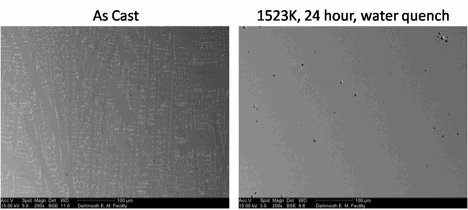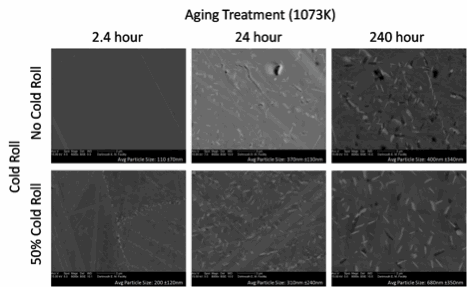www.acsprf.org
Reports: ND1049157-ND10: Novel High-Temperature Austenitic Alloys for Energy Conversion Applications
Ian Baker, Ph.D. , Dartmouth College
As existing fossil fuel reserves are depleted, the importance of efficiency in fossil-fired power conversion applications cannot be overstated. Efficiency in power plants can be achieved by increasing the operating temperature, but this will require new materials with substantially improved high temperature creep and oxidation resistance compared with current state-of-the-art ferritic steels, which are limited to about 620°C (Leyzerovich 2009). One promising class of materials is the alumina-forming austenitic (AFA) stainless steels. Currently, the best of these steels are strengthened by nano-scale carbides, but these are susceptible to coarsening during creep and over the long high-temperature service life demanded of power plant components. An alternative, and the focus of this project, is to enhance strengthening using Fe2Nb Laves phase intermetallic precipitates. These precipitates have been successfully precipitated in fine, homogeneous dispersions in AFA alloys, and exhibit exceptional stability at high temperature. However, they have not yet been successfully refined to a size at which their contribution to creep resistance would be comparable to existing carbide strengtheners (<~100nm). Additionally, while Laves phases have been shown to be stable in the matrix, when this brittle phase precipitates at grain boundary sites it has been shown to coarsen and eventually act as a medium for crack nucleation and propagation, reducing material toughness and creep life (Padilha et al. 2005). This project aims to achieve the following:
1) refine the matrix Laves phase to <100nm, which it will significantly enhance creep resistance;
2) reduce the fraction of Laves phase that massively precipitates at grain boundaries.
To achieve these aims, a novel method of precipitating the Laves phase is being employed. After applying a homogenizing solution heat treatment to the material, cold work (via cold-rolling) will be used to introduce a high density of dislocations in the matrix. If sufficient dislocation density is achieved, the nucleation rate of particles in the matrix (either homogeneously, or on dislocations) will be increased enough to both refine the Laves phase and limit the amount of precipitation that occurs on grain boundaries.
The first step in this process is achieving a solution-treatable material that will allow for the attainment of a single-phase matrix with Nb in supersaturated solution prior to cold rolling and aging. The alloy initially selected, Fe-20Cr-20Ni-2Nb-5Al (compositions in at. % throughout) was deemed unsatisfactory in this regard, as a single-phase γ-Fe matrix could not be attained at any temperature up to the melting point. Following this realization, several alloy compositions and homogenization temperatures were attempted before an effective combination was identified. Thus, the base alloy for work on this project has been defined as Fe-20Cr-30Ni-2Nb-5Al. This is homogenized using a 1523K, 24-hour heat treatment, and then quenched to retain the fully solutionized state, see Figure 1.
The alloy has been pre-strained and aged, and the resulting microstructures have been analyzed. To date, thickness reductions of 50% and 90%, and aging at 1073K for 2.4, 24, and 240 hours have been performed, see Figure 2. Laves phase sizes as small as 110 nm have been observed at short aging times, but after longer treatments the precipitate size increases to 300-400nm. Work is currently under way to study the fine structure of some precipitates, along with their composition, using transmission electron microscopy.
Figure 1. Secondary electron images of Fe-20Cr-30Ni-2Nb-5Al in the as-cast state and after an anneal at 1523 K for 24 h followed by water quenching.
Figure 2. Secondary electron images of solutionized Fe-20Cr-30Ni-2Nb-5Al after either cold rolling and annealing or simply annealing for 2.4, 24 or 240 hours.
Concurrently, attempts are being made to combine the precipitate refining technique with alloying additions that are known to improve the Fe2Nb morphology. Additions of Zirconium (0.2 at.%) have been shown to improve the mechanical properties of Fe-20Cr-30Ni-2Nb (Yamamoto et al. 2008). A study on whether an alloying addition of Zirconium to the base alloy, Fe-20Cr-30Ni-2Nb-5Al could yield a single-phase γ-Fe matrix with Nb in supersaturated solution was also conducted, but to date, only the Fe-20Cr-30Ni-2Nb-5Al alloy yields a matrix that allows us to control the precipitation of Fe2Nb through pre-straining and heat treatments.
The addition Silicon (0.4 at. %) has been shown to refine and stabilize the size of the Fe2Nb Laves phase precipitates (Yamamoto 2008). After a combination of straining and aging is achieved that gives a desired scale and dispersion of precipitates for the Fe-20Cr-30Ni-2Nb-5Al alloy, the method will be extended to an alloy that has additions of silicon to determine whether even smaller Fe2Nb precipitates can be obtained after appropriate pre-straining and solution treatment.
References
A.S. Leyzerovich(2009)"Supercritical-pressure power plants: a progress report", Modern Power Systems,29:31-37
A.F. Padilha, I.F. Machado and R.L. Plaut. (2005)"Microstructures and mechanical properties of Fe-15%Cr-15%Ni austenitic stainless steels containing different levels of niobium additions submitted to various processing stages", Journal of Materials Processing Technology, 170:89-96
Y. Yamamoto, M. Takeyama, Z.P. Lu, C.T. Liu, N.D. Evans, P.J. Maziasz and M.P. Brady. (2008) "Alloying effects on creep and oxidation resistance of austenitic stainless steel alloys employing intermetallic precipitates" Intermetallics,16: 453-462


